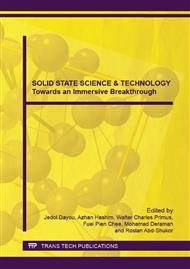[1]
F. Daniels, J.K. Rieke,. Thermoluminescence studies of aluminium oxide.J. Phys. Chem. 61, (1957) 629-633.
Google Scholar
[2]
X.B. Yang, H.J. Li, Q.Y. Bi, Y. Cheng, Q. Tang and J. Xu, Influence of carbon on the thermoluminescence and optically stimulated luminescence of α- Al2O3: C crystals. Journal of applied Physics. 104 (2008) 112-123.
DOI: 10.1063/1.3050344
Google Scholar
[3]
Chen Reuven, Advantages and disadvantages in the utilisation of thermoluminescence (TL) and Optically Stimulated Luminescene (OSL) for radiation dosimetry. Radiation Protection. 1, (2001) 1-8.
Google Scholar
[4]
K.R. Nagabhushana, B.N. Lakshminarasappa, D. Revannasiddaiah, D. Haranath & Fouran Singh, Swift heavy ion induced thermoluminescence studies in polycrystalline aluminium oxide. Indian Journal of Engineering & Materials Sciences. 16 (2009) 161-164.
Google Scholar
[5]
V. Kortov, Materials for thermoluminescent dosimetry: Current status and future trends. Radiation Measurement. 42, (2007) 576-581.
DOI: 10.1016/j.radmeas.2007.02.067
Google Scholar
[6]
A.J.J. Bos, High sensitivity thermoluminescence dosimetry. Nuclear Instruments and Methods in Physics Research B. 184 (2001) 3-28.
Google Scholar
[7]
L. T. Ying, H. Wagiran, S. Hashim and R. Hussin, Overview of the sensitivity of Ge- and Al-doped silicon dioxide optical fibres to ionizing radiation, Malaysian Journal of Fundamental & Applied Sciences. 8 (2012) 219-223.
DOI: 10.11113/mjfas.v8n4.164
Google Scholar
[8]
D. Lo , J.L. Lawless and R. Chen, Superlinear dose dependence of high temperature thermoluminescence peaks in Al2O3:C. Radiation Protection Dosimetry. 119 (2006) 71-74.
DOI: 10.1093/rpd/nci642
Google Scholar
[9]
M.S. Akselrod, V. S Kortov, D.J. Kravetsky, V.I. Gotlib, Highly sensitive thermoluminescnece anion-defect a- Al2O3: C single crystals detectors. Radiation Protection Dosimetry. 33 (1990) 119-122.
DOI: 10.1093/rpd/33.1-4.119
Google Scholar
[10]
M.L. Chithambo, Concerning secondary thermoluminescence peaks in a- Al2O3:C. South African Journal of Science. 100 (2004) 154-157.
Google Scholar
[11]
W.M. de Azavedo, G.B. de Oliveira, E.F. da Silva Jr, H.J. Khoury and Oliveira de Jesus, Highly sensitive thermoluminescence carbon doped nanoporous aluminium oxide detectors. Radiation. Protection Dosimetry. 119 (2006) 201-205.
DOI: 10.1093/rpd/nci684
Google Scholar
[12]
Y.X. Bo, X. Jun, L.H. Jun, B.Q. Yu, Thermoluminescence and optically stimulated luinescence disadvantage of α-Al2O3: C crystal grown by the temperature gradient technique, Chin Phys.B. (2010) 19.
DOI: 10.1088/1674-1056/19/4/047803
Google Scholar
[13]
M. Zahedifar, L. Eshraghi, E. Sedeghi, Thermoluminescence kinetics of α- Al2O3: C at different dose levels and populations of trapping states and a model for its dose response. Radiation Measurements. 47 (2012) 957-964.
DOI: 10.1016/j.radmeas.2012.07.018
Google Scholar
[14]
E. Pekpak, A. Yilmaz, G. Ozbayoglu, An Overview on Preparation and thermoluminescence Characterization of Lithium Borates for Dosimetric Use. The Open Mineral Processing Journal. 3, (2010) 14-24.
DOI: 10.2174/1874841401003010014
Google Scholar
[15]
C. Furetta, Handbook of Thermoluminescence,: 2003, World Scientific.
Google Scholar


